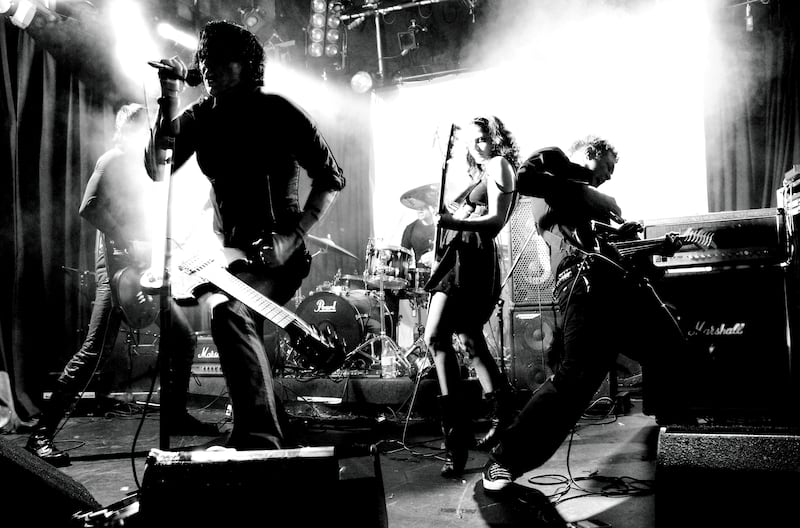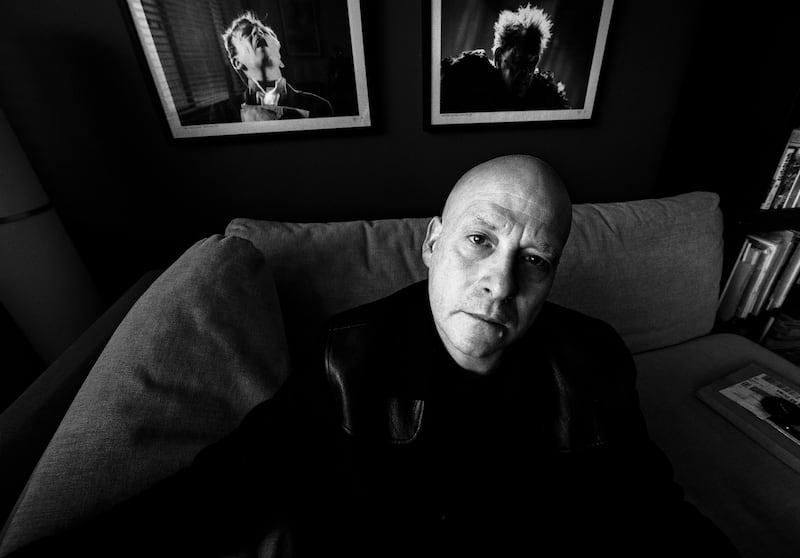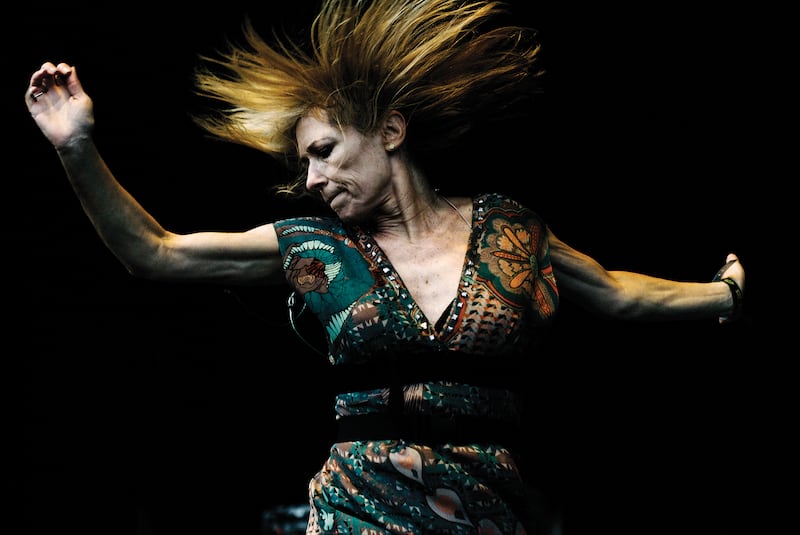Rain runs down the lens-like window of an establishment in Sandymount. Cormac Figgis sits with a copy of Shot From All Sides, his book of rock photography. His portraits catch the face and body in elemental performative moments. Human features are twisted, contorted, communicative; their owners lost in the delivery of onstage sonic art.
“I love shooting gigs, and if I like the band playing then it’s even better. I try to capture their integrity, their conviction. When you look back at the whole punk and post-punk thing, those bands were genuinely chasing something, making music they really believed in. There seems to be more intelligence behind what they are doing. More integrity.”
Figgis is a fine graphic designer with many credits to his name – his work on album and CD covers is striking. His photos of live performance focus music into explicit moments of stage ecstasy. But the agony is always waiting in the wings.
White powdery skin against eternal dark. It’s Jaz Colman from Killing Joke – the shot is angled and close up and he looks reptilian. The book includes stunning shots of Mark E Smith, Nick Cave, Wilko Johnson, Iggy Pop, John Lydon, Mick Jones, Lydia Lunch and Aoife Destruction. There are great captures of Dave Vanian, Sinéad O’Connor, Steve Diggle, Kaz and Molly Vulpyne, Genesis P-Orridge, Siouxsie Sioux, Julian Cope, Poly Styrene, Kim Gordon, Jello Biafra, Deko, Peter Hook, The Shend, Gary Numan and John Cooper Clarke. They all perform in limbo, protruding from the thick black soup of dark. His subjects are plucked out, isolated, abducted from the band that is their powerhouse. Motion and sequence stop dead in frozen moments. Figgis traps a snap of vision that is to the performer’s overall appearance what a snip of sound wave is to their tune.
READ MORE
“A lot of what happens is intuitive – composition, knowing when to grab a shot, editing. Like my head is giving me instructions I just follow,” he explains. “Black and white is timeless and theatrical. It gives a better sense of place and emotion. Colour is a distraction and only really works if it helps the story the photo is telling. I do all this for myself. I used to send on my photos to bands’ management but almost always got no response. I also tried in vain, for a number of years, to see if I could get music papers involved.”
Can Figgis imagine a musical culture without a photography? “If most of the photos of bands and performers out there did not exist, we would not be missing much. Social media is full of photographers but most don’t do anything for me. A lot just point and shoot. But powerful photography adds to the culture of the music. It adds to its art.”

Within a performer’s facial gesture, there lurks something precise, definitive and sculptural. Figgis’s shots chisel this out and make sense of the blur of artistry, of sound and light, of instrument and flesh, of microphone and mouth.
“My general focus is the singer – that’s where the performance is most of the time. But some bands have a guitarist who is all over the place. I enjoy the tension.”
Figgis’ challenge is to observe a performance with one eye through the lens and the other defensively scoping what he is simultaneously missing elsewhere on the stage. It is all opportunity cost. The camera as a microscope must map a vast terrain. He has set himself the task of hunting down visual essences for photographs that make an instant endure.
“It’s trying to grab that split second. If you are a moment too late or too soon, it is gone and you have to wait for the next one.” A good performance is a sequence of critical moments? “The first time I shot The Stooges there were loads of moments where I was half a second too late. But with someone like Iggy there is always another moment. I get distracted checking out something elsewhere on the stage. And then, aaaah no, he did that and it’s now gone. I swing around and try to shoot but am too late. With bands I am familiar with, it’s easier to capture those moments. I have an idea of what to expect. But it’s still fishing.”

He uses a Nikon D700 mainly and a 70-200mm zoom. Sometimes a wide-angle lens, say in a small venue where he is close to the stage. Or a 28-70mm zoom. “Most pictures are taken with the 70-200 because I am more after the face and the expression. But if they are a lively performer, it’s great to get the whole body in.
“I try to limit myself in Photoshop. I get satisfaction knowing what you are looking at is pretty much what you were looking at on stage. I’ll recrop but not a large amount. I like a lot of space around the subject matter – it adds to the drama and atmosphere and there’s a lot of black around the face. I try to do that with the framing.”
Do audience members ever tell him to get out of the way?
“In a venue where there’s no pit, if I stand in one place for too long, I’ll get a jab in the back ... I just ignore them. Hah! I’ll spend time to one side of the stage and then the other. Say in Whelan’s when it’s packed, I try not to be in anyone’s way and get my shots across the stage.”
[ Shooting the band: how to make a career as a rock’n’roll photographerOpens in new window ]
A jostling crowd. A dig in the ribs. The eye of the lens. Any fears for his camera getting broken in the destructive environment of music and drink?
“Generally no – cameras are quite sturdy. When I was playing bass in Paranoid Visions, we did a gig with a Polish punk band from the late 1970s in the Voodoo Lounge. I was getting thrown around. My camera got covered in beer. But most of the time I am in the pit. I go to gigs sober and I leave sober. Walking through town at 1am, it’s pandemonium. It makes sense to have my wits about me so I don’t get robbed or forget my camera.”
Figgis’ photos excavate primal parts of rock’s visual identity. His book is a periodic table of the elements of stage artistry.

“I started putting this book together around 2016. I thought: Who am I trying to kid? They are just a bunch of photographs, not that good or interesting. And then, a couple of months later, I’ll go through it and think, that is really good work. It’s a cycle. Up and down.
“I feel weird going to a gig now without a camera in my hand. I would love to travel with a band for six months and just take photographs at gigs and document a tour – behind the scenes, on the bus, in the hotel, rehearsals and the live stuff. If there’s anything to come out of this book, maybe that’s it. But it’s something I’ll leave behind. A legacy. It’s been a work in progress – my procrastination stems from a lack of confidence rather than laziness. Initially I wanted to look for a publisher for distribution. I was still pushing it around when Rotator’s Peter Jones said to me just do it. Do it yourself. DIY. Punk rock.”
Shot From All Sides by Cormac Figgis is available at rotatorvinyl.bandcamp.com/merch/cormac-figgis-shot-from-all-sides-book
Figgis tips: Making it click
– “Irish venues have notoriously poor lighting, especially the Olympia. It’s all backlighting into the audience. I shot Motõrhead there and it was virtually impossible to get a good clear shot of Lemmy. It was all silhouette, backlit. Just fuzz and grain, no detail. When I take pictures, I need light. As a punter at a gig, I am extremely aware of the light.”
– “Punk audiences are great to photograph. The main stage at the Rebellion festival is mad, a constant sea of bodies coming over the barrier.”
– “I try not to shoot bursts unless I know there is a potential sequence and a whirl of movement coming up. And I hope one of the shots will have nice movement or drama and blur. I am always waiting, hunting for that special spilt second.”




















